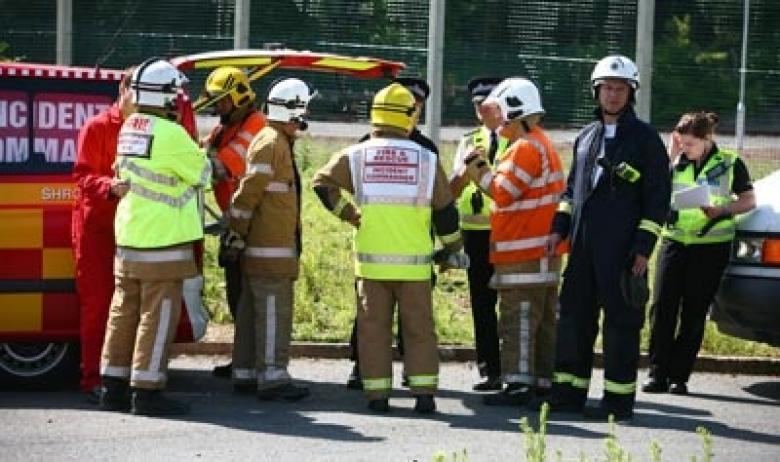
A group of people, some with breathing problems, are exposed to an unknown contaminant in Exercise Brave Heart a major training operation launched by Shropshire Fire and Rescue Service in which emergency crews have to cope with a potentially life threatening situation.
The exercise in Chemical, Biological, Radiological, Nuclear (CBRN) and mass decontamination procedures took place at a Shropshire military establishment at MOD Donnington in Telford, Shropshire, involving a total of 50 firefighters, 30 police, Army, RAF, Environment Agency and the ambulance's Hazardous Area Response Team (HART) from the West Midlands.
Students from Telford College of Arts and Technology play the part of eastern European workers who start to feel unwell and experience breathing difficulties and a burning sensation in the mucuous membranes after being exposed to the mystery contaminant while moving boxes. One of the workers dropped a box burning his hands which triggered off the major incident.
Tom Smart (16) and other students coming out of the decontamination unit.
A call was received at fire service control in Shrewsbury. On arrival at the scene firefighters from Shrewsbury and Tweedale fire stations join MOD fire officers to marshall 25 people into an area behind a building to isolate any spread of the possible contaminant which could be radioactive, an unknown chemical or part of a terrorist attack.
A convoy of six retained rangers from across the county, Incident Command and the Incident Response Unit from Shropshire Fire and Rescue Service also arrive at the scene to prepare for mass decontamination.
A disrobing unit is set up where Chemical, Biological, Radiological and Nuclear trained West Mercia police officers put on protective gear to approach people who may have been contaminated with the harmful substance.
Police officers in orange protective gear.
Using equipment from the New Dimension project, a 50ft long public decontamination unit is set up in three sections and a 100 metre exclusion zone is set up around the contamination point. Two firefighters wearing green "gas tight" suits made of Tychem, a specialist material to resist a chemical attack, take a sample of the mystery powder. It is chemically assessed on site with a computer scanning for information from 5,000 known chemicals.
If the substance cannot be identified, details are then sent via satellite to US scientists for an instant analysis. Within 20 minutes, the results are back and firefighters from the Detection, Identification and Monitoring team from Staffordshire Fire and Rescue Service deal with the chemical compound. Along with West Midlands Fire and Rescue Service, they are the two brigades in the region with this capability.
Meanwhile, victims are brought out of the isolation zone by policy one by one and asked to remove all their clothing which is then bagged and tagged and they put on an orange cape. They are then taken through the decontamination unit – a shower with detergent to completely remove any possible contact to their skin from the rogue substance.
Members of the HART medical team with an injured worker .
The exercise was being observed by both fire, police, and civil contingency emergency planners and the Local Resilience Forum.
"This is our sixth training event and the second this year and is a very useful multi agency exercise in which we work together to co-ordinate our approach to a potentially hazardous and life threatening incident. We are training for our dedicated response team of Shropshire firefighters who can be deployed wherever there is an incident in the UK," said exercise organiser Neil Griffiths, from the fire service training department.
He thanked MOD Donnington for helping them to achieve their objective of training personnel who are on standby to mobilise to any CBRN incident.
"We continue to prepare for such events," added Mr Griffiths.




